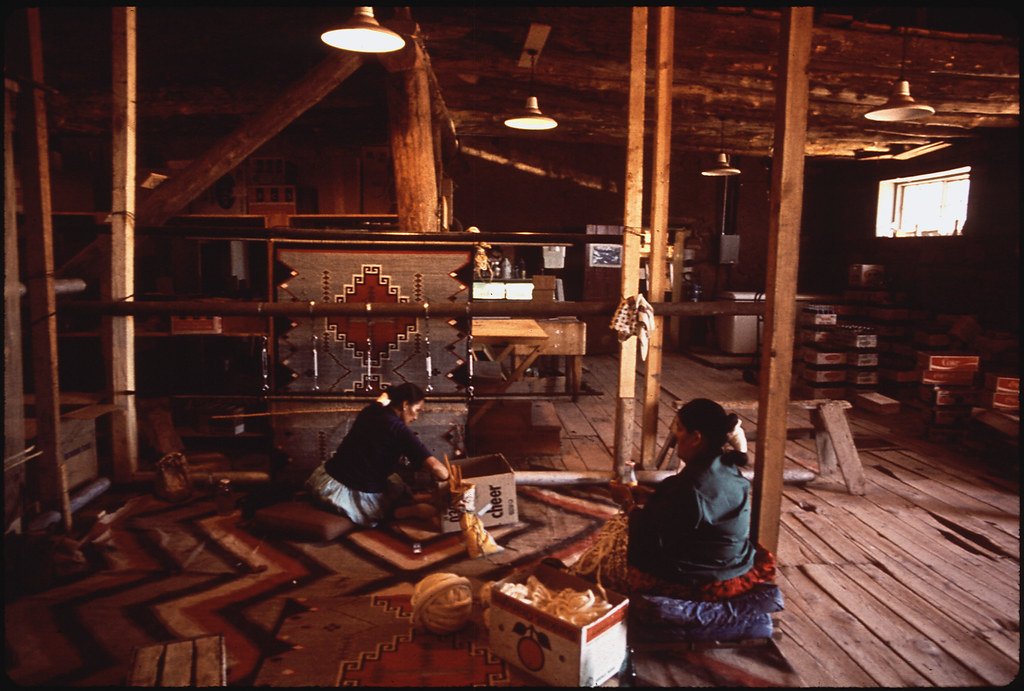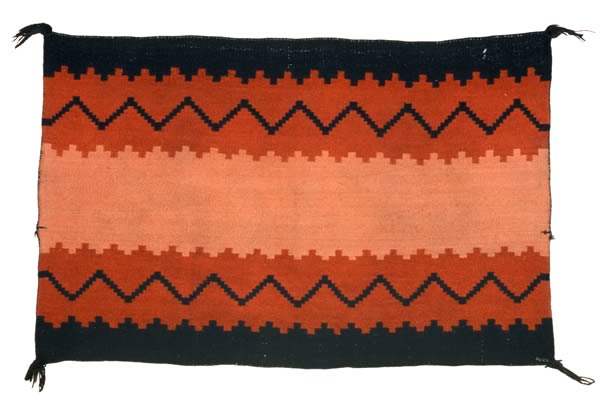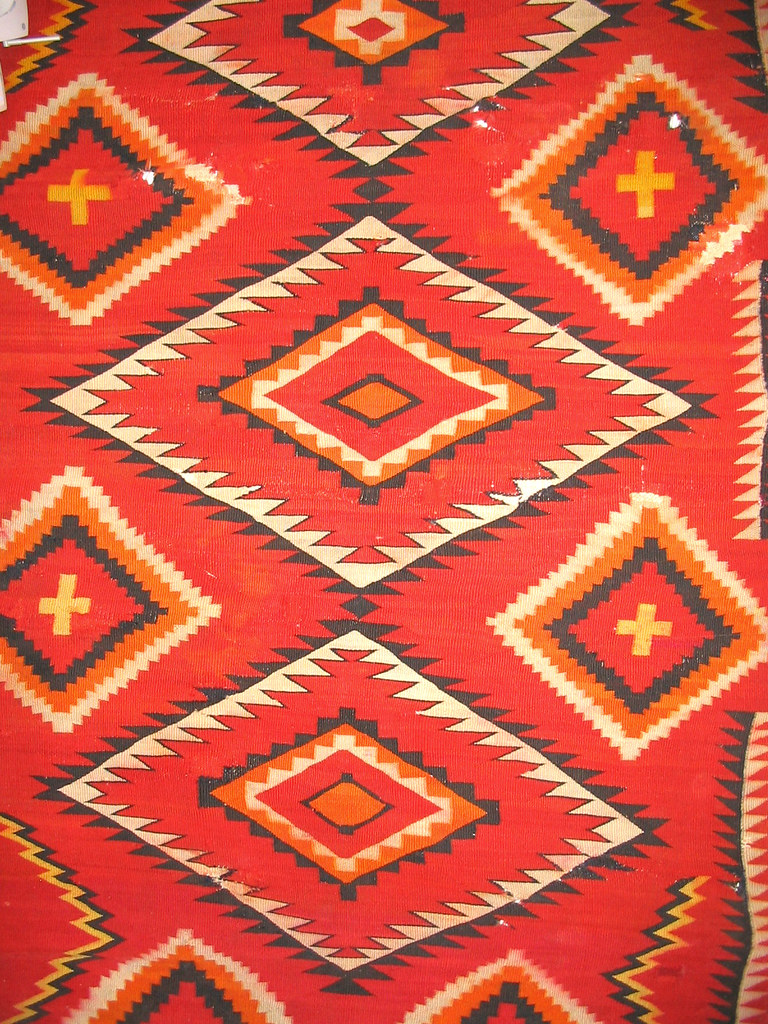.

Navajo Weavers At Hubbel Trading Post, the First Such Post on the Navajo Reservation, Ganado County, Arizona: photo by Terry Eiler for U.S. Environmental Protection Agency, May 1972 (National Archives and Records Administration)
Whatever man makes and makes it live
lives because of the life put into it.
A yard of India muslin is alive with Hindu life.
And a Navajo woman, weaving her rug in the pattern of her dream
must run the pattern out in a little break at the end
so that her soul can come out, back to her.
But in the odd pattern, like snake marks on the sand
it leaves its trail.
lives because of the life put into it.
A yard of India muslin is alive with Hindu life.
And a Navajo woman, weaving her rug in the pattern of her dream
must run the pattern out in a little break at the end
so that her soul can come out, back to her.
But in the odd pattern, like snake marks on the sand
it leaves its trail.
D. H. Lawrence: Whatever Man Makes, from Pansies, 1929

Woman's fancy manta, Navajo, c. 1850-1865: image by PDTillman, 2009 (Arizona State Museum)

Navajo blanket, 19th century: photo by George Wharton James, from Indian Blankets and their Makers, 1914

Transitional Navajo blanket, c. 1880-1895: photo by Flair Robinson Studio, 4 March 2009

Navajo Indian rug weaver with partially completed rug in loom, Southern Navajo Agency: photographer unknown, 1933 (Department of the Interior/Bureau of Indian Affairs/National Archives and Records Administration)

Spinning wool into yarn to be used in Navajo rug weaving, Southern Navajo Agency: photographer unknown, 1933 (Department of the Interior/Bureau of Indian Affairs/National Archives and Records Administration)
Navajo women weaving one of the very
large rugs for which Southern Navajo (Ganado district) Indians are
famous, Southern Navajo Agency: photographer unknown, 1933 (Department of the Interior/Bureau of Indian Affairs/National Archives and Records Administration)

Blanket weaver -- Navaho: photo by Edward W. Curtis (1868-1952), from The Apache; The Jicarillas; The Navaho [portfolio], Seattle, 1907 [Curtis caption: "The Navaho-land blanket looms are in evidence everywhere. In the winter months they are set up in the hogans, but during the summer they are erected outdoors under an improvised shelter, or, as in this case, beneath a tree. The simplicity of the loom and its product are here clearly shown, pictured in the early morning light under a large cottonwood."] (Northwestern University Library/Library of Congress)

Blanket weavers. Aboriginal life among the Navajoe Indians. Near old Fort Defiance, New Mexico: photo by Thomas H. O'Sullivan (1840-1882), 1873 (Library of Congress)

Navajo woman at loom weaving a blanket. A wooden crate that reads: "Charles Unsweetened Evaporated Milk" is near the woman. A herd of sheep walk on a ledge nearby. A stone and earth hogan is near the sheep: photo by William M. Pennington, between 1904 and 1932, from John Stewart MacCrary: "'Feel' of the desert", in The Desert Magazine, January 1940 (Library of Congress/ Western History/Genealogy Department, Denver Public Library)

Navajo woman weaver spinning wool into yarn at loom, Torreon, New Mexico: photo by John K Hillers (1843-1925), c. 1871-c.1907 (Smithsonian Institution. Bureau of American Ethnology/national Archives and Records Administration)

Navajo Rug Weaving: Kodachrome photo by Ray Manley, n.d ; original postcard caption: "From high in the sheep ranges of the Indian country come these pure wool masterpieces of the Navajo's rug weaving skill.Traditional Navajo weaving used upright looms with no moving parts. Support poles were traditionally constructed of wood although steel pipe is more common today. The artisan sits on the floor during weaving and wraps the finished portion of fabric underneath the loom as it grows. The average weaver takes anywhere from 2 months to many years to finish a single rug"; image by by Brenda (9teen87), 9 September 2011

Navajo girls learn first to weave by observation, near Navajo Mountain, Utah: photo by John Collier, 1948; image by John Collier, Junior, 11 November 2006

Navajo women weave a rug at the Hubbel Trading Post, first trading post on the Navajo Reservation: photo by Terry Eiler for U.S. Environmental Protection Agency, May 1972 (National Archives and Records Administration)






20 comments:
What we see
in these flat old blankets
is most often money ‒
a whole universe
laid out wrong
My first trip to the US before I lived here was to Arizona
The scale of the land and its intricate detail not apparent at first glance teased me out of my little island dwelling mentality . . .
The collective element in the cultural tradition that permits the individual to make things in which a bit of the individual soul is invested, even as the whole is reaffirmed -- I think Lawrence sussed out a bit of that, from his usual intense anxious distance of interested observation, in seeing such weavings made.
Not that Lawrence was unaware of what tourism had done to the indigenous cultures of the Southwest: "Just a show! The south-west is the great playground of the white American. The desert isn't good for anything else. But it does make a fine national playground. And the Indian, with his long hair and his bits of pottery and blankets and clumsy home-made trinkets, he's a wonderful live toy to play with." (DHL to Willard Johnson, "Just back from the snake dance", Questa, New Mexico, late August 1924)
a long trail.....beautiful...!!!
The trail of the tail of a tale in the sand has the loops and turnings and returnings of a life.
Lawrence's own alas not a very long one, but still with its particular twists that made the art possible, however tormented at times the life.
The honesty. The caring and not caring. The not by your leave and the in your face.
Perhaps one or two of those who have been hanging about this dry arroyo will have wondered whether the John Collier who took the penultimate photo here might possibly be one and the same with the John Collier who made some of the most striking images ever made of the part of New Mexico where Lawrence had his extended sojourn. A patch of Earth which is indeed a church in the sky.
Lawrence ends his "Snake" poem--which immediately came to mind-- with the sense of the smallness of the observer only
"And so, I missed my chance with one of the lords
Of life.
And I have something to expiate:
A pettiness"
Yes, he's always involving the living moral individual in the collective twistings of the tail, and investing value on the one hand (in the not "civilized") and detecting its depletion and indeed evanishment on the other (in/from the way things are).
How inconvenient. This sort of thing was never going to do for the tenured latterday avantgardistas. You'd naturally not want to invest your "texts" with your career ambitions too openly, assuming those are what passes for your values. Small wonder Lawrence no longer exists, in an age dedicated to its comforts his uncomfortableness was always going to cause discomfort.
Poetry takes what is surrounding and shapes it, using what's available--sticks, animal pelts, rocks for weight. Some poems are like math, like geometry but still rough, scratchy. Those are the desert poems. You may ask, what is all this color about, these shapes? Are they learned or made up, all the while watching for wolves, for anything changing.
It was
a great relief
when I could go
to the loom
and someone else
had to watch the kids.
I had switched jobs
with my man
in order to survive.
Yes, Lawrence, rough, scratchy on the skin the fabric -- the abstract design always shows through.
The colours and the shapes.
Not till the railroads came in the Eighties, bringing aniline dyes among other bloody additives, could the bright red colours ("eyedazzlers") be obtained.
Some trace the geometries back to octagonal designs from the weavers of the Caucasus. Abstractions come from and in turn speak back to pattern recognition centres in the mind that are probably universal.
Don Lorenzo Hubbell (he of the trading post, top and bottom images), by the way, was a half Spanish half Anglo trader whom the Navajo weavers evidently trusted a great deal. He was the first white man to be buried on Navajo lands.
Coronado and his men
well, asked for directions
yet
gave them
instead.
After this
we had to deal
with the wool.
Coronado who?
enquired the ewe.
Having seen the men come and go.
Not all of them
were looking
for gold
so obviously
hungry.
Yes, the lowly foot soldier, that dupe of history.
Poor white men, always hungry for something, always walking, always exhausted, always starved for more words, more gold.
Poor Coronado, misled by Friar Marcos de Niza about Cibola which turned out to be nothing but a small development of modest Zuni pueblos, not a pot of gold, and by the lying Sioux or Pawnee named the Turk, about Quivira, where there turned out to be only a lot of naked Indians, and less precious metal than was already in Coronado's shiny hat.
Such a very long way to go for so much nothing.
There's an account of the voyages by George Winship: The journey of Coronado, 1540-1542
The Navajo appear to have learnt weaving from the ancient Pueblo people -- the Anasazi, or Enemy Ancestor.
Lawrence seems to have got a pretty good sense of what darknesses lay huddled in waiting under those woven blankets of the ancient night.
Mountains blanket-wrapped
Round a white hearth of desert --
While the sun goes round
And round and round the desert,
The mountains never get up and walk about.
They can't, they can't wake.
They camped and went to sleep
In the last twilight
Of Indian gods;
And they can't wake.
Indians dance and run and stamp --
No good.
White men make gold-mines and the mountains un-make them
In their sleep.
The Indians laugh in their sleep
From fear,
Like a man when he sleeps and his sleep is over, and he can't wake up,
And he lies like a log and screams and his scream is silent
Because his body can't wake up;
So he laughs from fear, pure fear, in the grip of the sleep.
A dark membrane over the will, holding the man down
Even when his mind has flickered awake;
A membrane of sleep, like a black blanket.
In the Shadow of the White House Ruins
if blankets could talk..baby blankets, hotel blankets, these blankets.
The questions about Quivira were always answered
by pointing to the north.
The march Coronado’s army made in 1541
brought him there—
Quivira was a village of Wichita Indian teepees.
Coronado writes to the King October 20,
“…some Indians who were natives of other
provinces beyond these had told me that in their
country there were much larger villages and better
houses than those of the natives of this country,
and they had lords who ruled them, who were served
with dishes made of gold, and other very magnificent
things; and although, as I wrote your majesty, I did
not believe it before I had set eyes on it, because
it was the report of Indians and given for the most
part by means of signs.”
It is mystifying that the natives gave Coronado
a piece of copper or gold he could hang around his neck—
the guides confessed they had led him on,
hoping they and their horses would starve on the plains.
I get hungry reading about it.
how there were grapes
along some streams
“of a fair flavor,
not to be improved upon.”
The poem, the photos and the comments invariably weave their own tapestry; in this one, I can see women like this one. Together with their looms, they were permanent fixtures of every Greek household not so very long ago.
Tom,
". . . run the pattern out in a little break at the end
so that her soul can come out, back to her."
And so the lines in the patterns continue --what else to say?
6.17
grey whiteness of sky next to shadowed
walls of buildings, line of black wire
in foreground, sound of cars in street
this setting itself as well
as what, something of
an ending suddenly leapt to
mind, then, answering
brick red wall against green of trees,
cloudless pale blue sky across from it
What beautiful rugs, better than the systemic paintings of the sixties so tied to the visible cycles of light, color, life.
And Lawrence. I'm just finishing Leavis's masterwork D. H. Lawrence: Novelist, the great book he deserved. He X-rayed civilization for us, I thought, when I read "The Lovely Lady" 20 years ago.
Dear TC: One of the first books I produced during my time at the Smithsonian's Indian museum was called Woven by the Grandmothers: 19th-Century Navajo Textiles from the National Museum of the American Indian; it included many beautiful works, similar to those you've posted here. One contributor wrote about "the spirit line": "If a weaver weaves a perfect rug, she makes a little mistake on purpose---an imperfection...so the rug will not be perfect." So as not to offend the divine. I wish I had known about Lawrence's poem back then, but thanks for turning me on to it now.
Unknown, I had that same feeling with the rugs. Abstraction in art comes from the mind and the soul. Money makes it fly back to the New York art gallery and the auction house.
Terry, this beautiful passage encompasses (and perhaps extends) the point of Lawrence's poem:
"One contributor wrote about 'the spirit line': 'If a weaver weaves a perfect rug, she makes a little mistake on purpose---an imperfection...so the rug will not be perfect.' So as not to offend the divine."
Did he say a snake?
Post a Comment